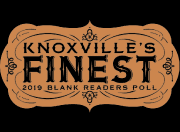
Violins of Hope returns to Knoxville this week for a month-long series of events aimed at educating the community about the Holocaust through the powerful stories of restored violins from Jewish Holocaust victims. The story of the Holocaust with the murder of 6 million humans and the loss of ⅔ of the European Jewish population is one of nearly incomprehensible numbers. The phrase “diminishing hierarchical scale,” used by Lou Gauci, the architect of the Violins of Hope exhibit, helps to contextualize and clarify the exhibit’s design, making its scale more comprehensible.

Scaling the Holocaust to one instrument and story at a time allows access to those who were lost and the implications for our world today. Owner of the Violins of Hope collection Avshi Weinstein, whose grandfather founded the organization, told me that “the numbers are too big to be able to understand them, to really understand them. We can understand the story of…individuals and their families. It’s something that we can relate to. But with the numbers which are by the millions, we can’t understand.”
Weinstein related that “Violins of Hope is a collection of instruments, most of them played by Jewish people before and during the Holocaust. They tell their own stories of families, of individuals who survived or some of them unfortunately died during the war…each violin is a story, family, legacy.” 70 violins will be at the 2025 event.

Event organizer Michael Grider of Foothills Strategies noted the rarity of a second Violins of Hope visit. Knoxville’s response in 2019, reported by Urban Guy here, caught the attention of Violins of Hope. When another city backed out, the group reached out. Rabbi Yossi and Miriam Esther Wilhelm of the Stanford Eisenberg Jewish Day School agreed to host again with less than a year to prepare.
Grider emphasized that, to host an event in such a short time, “it takes…a very involved community. We have a committee of about a half a dozen or so volunteer organizers from various backgrounds, not all of whom are Jewish.” With the 2019 space unavailable, Sacha Keenan, owner of Digital Motif at 108 S Gay Street, stepped up. Ashley Capps is making Violins of Hope one of the Big Ears events. And, volunteers from faith and other communities will keep the exhibition open during Shabbat.
The violin exhibition, school events and a book talk are free to attend. Two Knoxville Symphony Orchestra concerts require paid tickets with net proceeds benefiting the Knoxville Jewish Day School. Sponsors are helping defray the $150,000 cost.

The Hope in Violins of Hope
Though somber in nature, both Weinstein and Wilhem reiterated that these are stories of hope. Weinstein said, “Many people, when they heard music, it brought them hope. It brought them hope that these dark days will finish, will end. That they will go back to concerts, to their life. Right. And this is the hope. The music brought hope with it.” To resist the despair of the camps, musicians often risked their lives to play traditional music on Jewish holidays though many who played in camp symphonies survived until liberation because of music.
Mirian Esther Wilhelm told me the event was “not about just Holocaust education. It’s about what we can learn from it. And one thing, having grandparents as Holocaust survivors, they managed to go on and build a home.” During her visit to Auschwitz, where her family was imprisoned, she spoke of the power of seeing the “Arbeit macht frei” gate, where Jewish orchestras often played.
When asked about hope, Wilhelm said, “instead of being dragged down by what they experienced, they took that experience and found the joy and the appreciation and the gratitude and everything life brought them afterwards in a way that we take for granted.” Her grandmother told her, “Miriam Esther, why was the first thought we had after liberation was let’s get married and have kids? She said, I should not have wanted to bring children into the world after what I had seen. And yet our first thought was let’s rebuild.”
Violin Exhibit at Digital Motif
Lou Gauci of Louis Emmanuel Gauci Architecture and Design wanted to avoid repeating the 2019 design. The space at Digital Motif allowed him to rethink his design. Digital Motif relocated upstairs for the month and had a few requests that initially posed challenges but ultimately shaped the final design.

Gauci said that “I’ve included instruments that I think have particular resonance for our community, particularly at this time in our country’s position.” He selected 38 violins, with 15 new instruments, including Motele’s violin from the Yad Vashem Holocaust Remembrance Center in its first United States appearance. Guaci said of his design, “The critical part is that when you get from the room to the case, to the collection of cases, to the instruments themselves, there’s kind of a descending hierarchical component in terms of spatial scale.”

Vector lines draw your attention at the entrance. Gauci wanted to “create a space where people would start to slow down in their lives and just kind of become acquainted with what the stories were and what the Violins of Hope really started to represent.” Violins are housed in cases built by Ernie Gross, a well-known woodworker in the area, whose mother was a Holocaust survivor.
Gauci added, “The instruments themselves started out as a piece of wood, a tree in a forest somewhere. And the tree was felled, it was selected, it was brought down, and then cured, dried out, and then lovingly sliced,and then taken to a luthier shop who had picked it out, thumps on it to listen to its resonance, and realizes it’s the piece he wants to use for one part of that violin. Again, it’s a successively diminishing hierarchical scale of a tree to an instrument going through this process.”
One of these violins was 14-year-old Mordechai “Motele” Schlein’s. Forced to play for the Nazis, he joined the partisan group Diadia Mischa, using his violin case to smuggle explosives into a Nazi club. On his final mission, he detonated the explosives, killing Nazi officers before being later caught and killed. His story, and many others, fill the room.

Additional areas offer spaces for reflection. A “Memory Alcove” features three towering, triangular photo boards covering bookshelves that could not be moved. Gauci said that this space is “a convergence and collision of horror and hope.” Photo panels in low resolution are adhered with several mirrors allowing visitors to see their reflection imposed on those who were murdered. “You are experiencing it; you too could be a victim“ Gauci said.

Quotes on injustice fill the room. Above one set of cases, impressionistic photographs of victims are displayed. At the rear, a bench with a window with six squares subtly honors the six million lost. A small room displays memorabilia of the Palestine Orchestra and Bronislaw Huberman, who helped musicians find work in Palestine after the war. I asked Gauci if repeat visits would offer a deeper experience. Gauci confirmed that was his intention. After two visits, I agree.

Knoxville Symphony Orchestra Concert Series
Weinstein noted that music was deeply embedded in Jewish culture with the number of violins on a home’s wall indicating how many boys were in a Jewish family. Nazis created entire symphonies at concentration camps, at times forcing prisoners to play violin for those being sent to gas chambers.
Knoxville will have two opportunities to hear these instruments with KSO concerts on March 5th and April 8th. Click on the links to purchase tickets.
Trianne Newbry, Director of Communications for the KSO, provided this statement by Concertmaster William Shaub.
At the KSO, our upcoming Violins of Hope performances are filled with music that will take you on an educational and truly unforgettable journey. This journey, built on storytelling and evocative pieces of music by composers from J.S. Bach to John Williams, will take everyone at the Historic Tennessee Theatre—performers and audiences alike—through struggle, tragedy, remembrance, and ultimately, hope. These two performances are led by our music director Aram Demirjian and feature the amazing string instruments of the Violins of Hope collection, and they are ‘can’t miss’ concerts this spring.
I was able to capture KSO musicians auditioning violins in the video below.
Cal McLean, retired artistic director of the Clarence Brown Theatre, is working with volunteer actors to perform between songs. Though not a partner, many actors have performed on the Clarence Brown stage. Grider added of the performances, “you’ve got that physical sense, you’ve got that aural sense, you’ve got the visual is coming into play here. And so it’s really going to be…multi-sensory.”

Public and School-based Educational Events
Violins of Hope will include an educational component for 23 local schools with tailored programs for each. Educators will lead the sessions, accompanied by two KSO musicians. This initiative is sponsored by the Tennessee Holocaust Commission, Temple Beth-El, the Jewish Day School, the city of Knoxville, and the University of Tennessee’s Judaic Studies Department.
Wilhelm said, “Our goal, both through the exhibit and the concert and the school presentations, is to inspire students to think, what do I need to do to make sure that something like this can never happen again? Because we can all be victims of selfless hate. And we can all perpetuate senseless hate, sometimes subtly.”
For the public, the East Tennessee History Center on Sunday, March 9 from 2:00 to 3:00 will host James Grymes, English professor at the University of North Carolina, Charlotte, for book talk about his book, “Violins of Hope: Instruments of Hope and Liberation in Mankind’s Darkest Hour.” The Knox County Public Library and the Friends of the Library are covering the cost of this event, so the public can attend at no cost.
Calendar of Events
Violins of Hope will be an expansive event throughout March into early April. To help you keep track, here is a calendar with links to more information.
Violins of Hope Exhibit: March 3 – April 9
Knoxville Symphony Orchestra Concerts: March 5 and April 8
Author Talk, James Grymes, author Violins of Hope Book: March 9
Big Ears Festival Focus on Violins of Hope: March 27 – 30
School Educational Events: March 11 – 13 and April 8 and 9 (not open to the public)

























Recent Comments